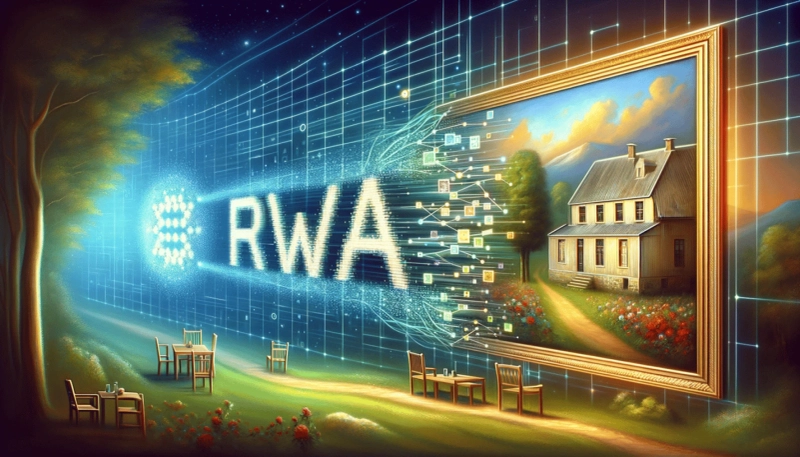The process of tokenizing real-world assets, or Real World Assets, converts physical assets into digital representations.
In practice, art items, commodities, real estate, public bonds, debentures, shares - among many options - can be tokenized.
On the rise, the segment is gradually advancing based on initiatives from the world\'s largest financial institutions and also central banks. Brazil is one of the countries with the greatest potential for evolution, in the medium term, due to the development of Drex - the digital real project.
Below, we detail the main points of the technology.
Real World Assets
RWAs get their name when tokenized assets become part of the blockchain infrastructure. Through DeFi technology - or decentralized finance - assets become divisible, transferable and tradable.
For financial institutions, technology has the potential to optimize systems and reduce costs associated with asset management. For customers, it means less bureaucracy when investing, exemption or reduction of intermediation fees and greater access to different types of products.
“This is a technology that has been developing over the last three years and has the potential to change the way we know and interact not only with our finances, but with any valuable asset in the physical world”, says Ricardo Santos, VP Engineering at Parfin.”
Tokenized assets
In theory, any asset can be tokenized. Today, in the financial market, the asset tokenization platform development of treasury bonds, fund shares, gold - among other assets - stands out. As there is no specific regulation, the systems run RWAs in controlled environments.
Below we detail some of the main use cases:
- Precious Metals: when tokenized, gold, silver and other precious metals can be purchased in fractional portions.
- Shares, debt securities and fund shares: tokenization brings to the market a more efficient way of trading and settling securities.
- Commodities: contributions to products such as oil or natural gas can be made more accessible with tokenization.
- Venture capital: tokens from a startup facilitate the transfer of ownership and have the potential to attract more investors.
- Intellectual property: tokenized patents or copyrights can be acquired with less bureaucracy and greater security.
- Luxury Goods/works of art: tokenized high-quality products allow investors to purchase shares of the items. It is possible to use assets as collateral for loans.
- Energy Credits: Tokenization can be applied to renewable energy projects, allowing investors to participate in the financing and ownership of green energy initiatives.
Adoption among financial institutions
Broadly speaking, RWAs translate into the democratization of access to financial services through their potential to facilitate loans, transfers and investments. It is no coincidence that some of the largest financial institutions in the world already promote projects that use blockchain and smart contracts with a focus on services linked to tokenization.
JPMorgan, which began research into blockchain in 2015, optimizes its private Quorum platform, created as a soft fork of Ethereum. CitiBank, in turn, advances with Citi Token Services for cash management and commercial financing with a focus on institutional clients.
In Brazil, Parfin has been technically supporting large institutions: Santander, during the Central Bank\'s Lift Challenge, and Banco BV, in the Drex pilot project. Both are pilot tokenization projects that aim to facilitate the purchase and financing of vehicles.
“Today we already have some decentralized finance (DeFi) platforms that are prepared and already have the necessary infrastructure to provide tokenized lending solutions to traditional financial market assets. Some new partnerships should emerge and, certainly, the innovation that happens at high speed in the decentralized world will boost the traditional market. Some pieces that are still necessary, such as compliance criteria and creating a cryptographic identity, are already in development.” says Santos.
RWA-specific token standard
The possibility of interconnecting systems in a tokenization infrastructure that has been studied by financial institutions around the world is the path to creating a global token market.
A step forward in this challenge was taken in mid-December 2023, when the Ethereum network community approved the ERC 3643 standard, the first to be custom developed to run RWA tokens.
Adopting a standard protocol of encourages the development of applications and projects that manage tokenized assets more efficiently. “This approval has the potential to attract even more financial institutions and companies to tokenization, which tends to accelerate the integration of the Ethereum blockchain into traditional finance,” says Santos.
Relationship between Drex and RWAs
Although the segment has shown significant advances in recent years, tokenized assets will only promote real change in the financial market when money is also tokenized.
In this context, Brazil is one step ahead of the world by promoting the Drex project - creation of the digital real, which is led by the Central Bank and is expected to be launched in 2025. “From the moment a legal tender currency tokenized technology flows in a single system, private institutions and clients will be able to capture the benefits of the technology”, points out Santos.
In practice, it will be possible, for example, for a person to tokenize their high-value luxury item, such as a watch, and offer the asset as collateral for a loan. “There are real possibilities like this that will accelerate the creation of specific regulations for the segment, which tends to unlock this market not only in Brazil, but throughout the world, by 2026”, says Santos.


